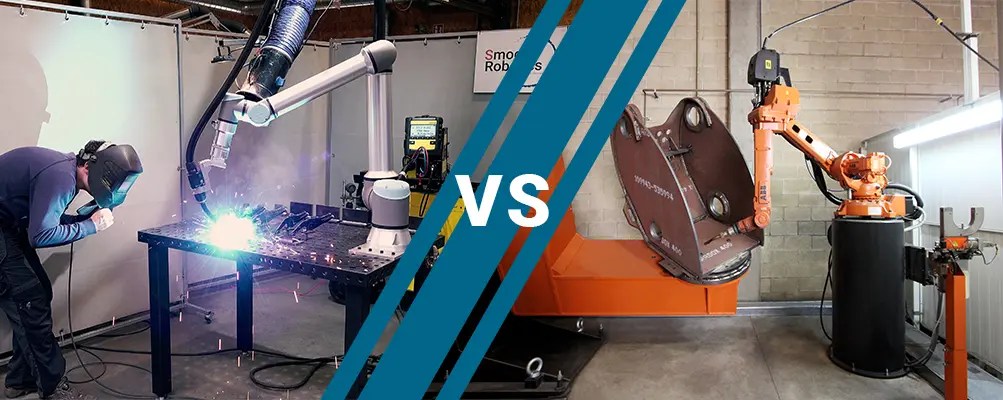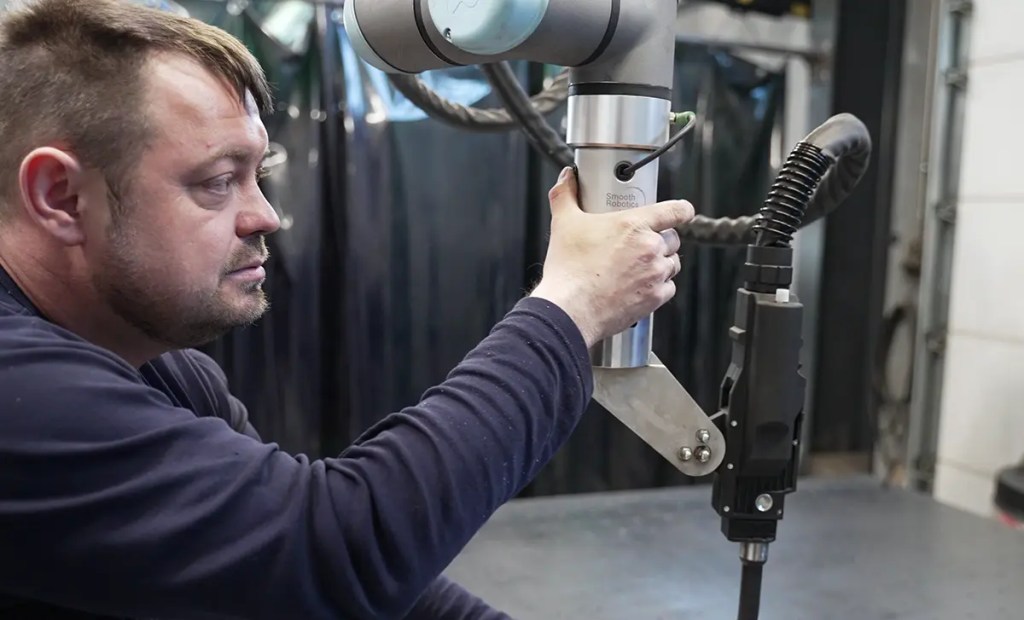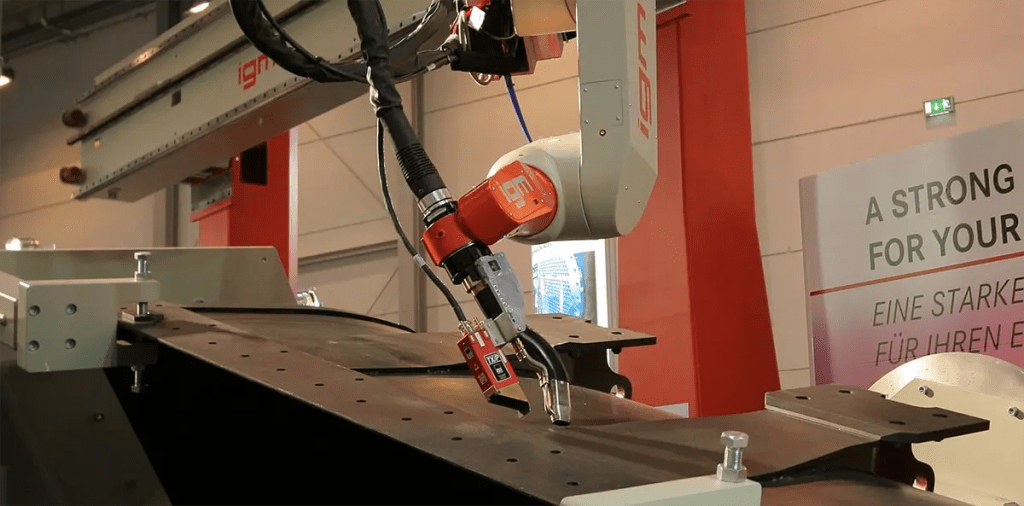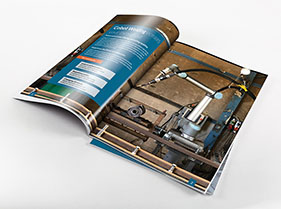Let’s start with 3 quick questions…
- Are you having trouble finding skilled welders?
- Do you want to increase your productivity?
- Do you weld parts that fit on a 2×1 m table?
If you can answer yes to those three questions, then you are more than likely to benefit from introducing a cobot welder to your team.
Read on to learn more about how cobot welding can benefit your company and what kind of tasks are the right fit for the robot welder.
Cobot Welder vs Robotic Welding Cell

To understand who can benefit from adding a cobot welder, we need to establish what a cobot welder is and what it is not.
A cobot welder should be seen as the welder’s tool and not as a fully automated robotic cell that can do work without human input.
The cobot needs to be operated by a human just like any other tool that the welder uses, and it needs input from a skilled welder to perform optimally. It does, however, not need input from a specialized robotic programmer like in traditional welding automation.
The safe nature of the collaborative robot makes it possible for the welder to be hands-on with the robot and move it around to teach it the welding path. This is in stark contrast to traditional welding automation, where industrial robots must be placed behind a safety perimeter and would be very dangerous to stand next to while running.
An industrial robotic welding cell will many times be part of a larger automation process where no or very little human input is needed once the programming is done. This setup can be viewed as fully automated but is very costly to implement and reprogram. This setup is a good fit for manufacturing processes with a high volume and low mix.
A cobot welder doesn’t need a dedicated floor space or safety perimeter and it is portable. It can be programmed quickly by your welder and doesn’t require a trained robotic programmer. It is a great fit for smaller manufacturers with a lower volume and higher mix. It is a flexible solution, that can be deployed quickly and at a lower cost.
Let The Cobot Do the Grunt Work!
To have a successful implementation of the cobot welder, the manufacturer must learn to use the cobot for the right tasks. Many new users are tempted to automate very complex welding jobs straight away, but in our experience, we see that starting out with simpler welds is the better approach.
The cobots excel with welds that have a long arc time and with circular welds that would be difficult to perform manually in one take. Basically, all the grunt work that is tedious and physically straining to do by hand.
By starting with all the low-hanging fruit in terms of welding tasks, you will get a quick return on investment and gain familiarity with the new tool.
You will also quickly figure out where the cobot can increase productivity straight away, where and how you can modify your current production flow to implement the cobot, and where it doesn’t make sense to use the cobot.
Once you’ve automated all the low-hanging fruit and gotten familiar with the cobot, you can begin to investigate breaking the more complex jobs into multiple simpler welds and produce the right fixtures and jigs for those parts.
Harness the Expertise of Your Skilled Welders

Getting the robot to do all the monotonous and repetitive welds frees up your skilled welders to perform more advanced procedures thereby using their acquired expertise and craftsmanship. This could be performing complex welds that are not a good fit for the cobot, setting up new programs on the robot, or it could also be testing and creating jigs and fixtures to be used with the cobot.
Skilled Welders are in short demand which means they are expensive and hard to find, so having them doing tedious and monotonous simple welds all day doesn’t make sense. It will not only give you a bad return on investment, but it will make your welders look for better job opportunities.
Giving your welders the best tools available will make them more productive, happier, healthier, and less likely to look for other job opportunities.
Advanced features
The true strength and benefit of a cobot welder stems from the fact that it is a hybrid solution taking the best attributes from both manual and robotic welding and getting rid of the downsides.
You get the fast changeover time and real-time human quality assurance from manual welding but without a lot of the safety and health issues, and you get the productivity and consistency benefits from traditional welding automation, but without the need for complex programming.
It is however important to keep in mind that a hybrid also comes with some compromises and that the cobot welder functions best when used for tasks that are within its intended capabilities.
A basic cobot welding setup will be able to handle most of the welds that the manual welder can do and some of the welds that a traditional welding automation setup can do. Cobots are generally smaller and slower than traditional industrial robots and thus can be limited in terms of reach and number of welds per minute.
Advanced features like seam tracking, touch sense, external axis manipulators, and camera vision can be used with a cobot, but they are normally better suited for traditional robotic welding. In many cases, upstream processes and cleverly crafted jigs can make the advanced welding features unnecessary. However, if that’s not possible, you need to consider carefully whether a cobot is the best fit for welding tasks that require these advanced features.
Seam Tracking

Consider the case of seam tracking — a valuable capability tailored to instances involving extensive and irregular welds. Seam Tracking employs advanced sensing technology to rectify welding trajectories, effectively compensating for deviations from the initial path.
Although seam tracking is a useful feature, it is important to know its limitations and the consequences it can have on productivity.
When setting up a welding program using seam tracking technology, it’s important to acknowledge that the setup process might be more time-intensive due to heightened intricacy. Should you choose to employ Through the Arc Seam Tracking (TAST), the robotic system is required to adopt a weaving pattern, inevitably leading to an augmentation in welding duration.
It is also important to recognize certain constraints associated with this approach. Notably, TAST is unsuitable for welds involving thin plate thickness, and it’s also incompatible with Aluminum welding.
SmoothTool, the cobot welding solution by Smooth Robotics has several advanced features in the software. There are no paywalls in the software and all features are available to all users with a valid license. This allows for experimentation with welding techniques that would normally be suited for an industrial robot, but we strongly recommend beginning with automating the simple, but time-consuming welds before dabbling with welds that require advanced features.

The greater the complexity of a collaborative robot (cobot) setup, the more it will resemble traditional welding automation. This, in turn, leads to increased programming skill requirements and job-switching times, which curtails the advantages of having a cobot welding setup.
Summing it up
In conclusion, if you’re grappling with the challenge of finding skilled welders, aiming to enhance productivity, and dealing with parts that fit within a 2×1 m table, the introduction of a cobot welder to your team could be a transformative solution.
A cobot welder operates as a collaborative tool, bridging the gap between manual and robotic welding. Unlike fully automated robotic cells, cobots require human guidance for optimal performance, eliminating the need for specialized robotic programmers.
The safety afforded by collaborative robots allows hands-on interaction and easy teaching of welding paths. While traditional industrial robotic welding suits high-volume, low-mix manufacturing, cobot welders offer portability, quick programming by welders, and cost-effective deployment for smaller manufacturers with varied needs.
By automating simpler welds first, businesses can swiftly reap returns on investment and identify productivity enhancements. The cobot welder amalgamates the best of manual and robotic welding, yielding efficiency gains without intricate programming. However, it excels within its capabilities, and advanced features might be more suitable for traditional robotic welding setups.
As you consider cobot welding, starting with simpler welds and gradually exploring more complex tasks can optimize your deployment.
Smooth Robotics’ Cobot Welding Solution, SmoothTool, offers advanced features to all users, emphasizing experimentation while urging prioritization of simple yet time-consuming tasks. The key lies in aligning the cobot’s capabilities with your welding needs, avoiding over-complexity to preserve the advantages of this collaborative and efficient solution.

